
Monaldo Trofi -- also known as Monaldo Corso or Monaldo da Viterbo or il Truffetta -- (active 1505-circa 1539) was an Italian painter of the Renaissance style active in Viterbo, region of Lazio, Italy.

Monaldo Trofi -- also known as Monaldo Corso or Monaldo da Viterbo or il Truffetta -- (active 1505-circa 1539) was an Italian painter of the Renaissance style active in Viterbo, region of Lazio, Italy.
Trofi was said to have been born in Viterbo in the late 1480s, but it is unclear with whom he trained. The obvious cited master is Antonio del Massaro (ca. 1450–1516), the main local artist of the prior generation. His style sometimes resembles Luca Signorelli. He is documented in 1504 in association with works at the Corneto Cathedral with the two painters above and Constantino di Jacopo di Zello. [1]
Most of his output, signed or attributed, are sacred paintings. He is said to have painted a Nativity for a church in Canino [2] He also painted an Enthroned Madonna and Child between St John Evangelist, St Francis of Assisi, St Jerome and St John the Baptist for the church of San Francesco in Canino. [3] The Walters Art Gallery in Baltimore has two tablets depicting St Anthony Abbot and St Sebastian, attributed to Trofi, and dated circa 1505. [4] He painted a Deposition located in the Museo Nazionale of Tarquinia dated 1507.

Domenico Veneziano was an Italian painter of the early Renaissance, active mostly in Perugia and Tuscany.

Lorenzo Lotto was an Italian painter, draughtsman, and illustrator, traditionally placed in the Venetian school, though much of his career was spent in other north Italian cities. He painted mainly altarpieces, religious subjects and portraits. He was active during the High Renaissance and the first half of the Mannerist period, but his work maintained a generally similar High Renaissance style throughout his career, although his nervous and eccentric posings and distortions represented a transitional stage to the Florentine and Roman Mannerists.
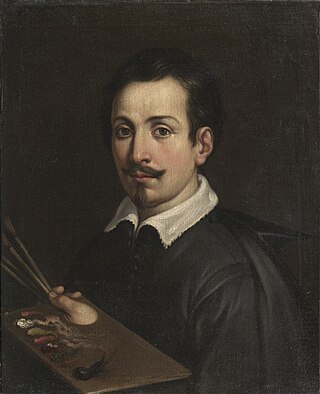
Guido Reni was an Italian painter of the Baroque period, although his works showed a classical manner, similar to Simon Vouet, Nicolas Poussin, and Philippe de Champaigne. He painted primarily religious works, but also mythological and allegorical subjects. Active in Rome, Naples, and his native Bologna, he became the dominant figure in the Bolognese School that emerged under the influence of the Carracci.

BartolomeoMontagna was an Italian Renaissance painter who mainly worked in Vicenza. He also produced works in Venice, Verona, and Padua. He is most famous for his many Madonnas and his works are known for their soft figures and depiction of eccentric marble architecture. He is considered to be heavily influenced by Giovanni Bellini, in whose workshop he might have worked around 1470. Benedetto Montagna, a productive engraver, was his son and pupil and active until about 1540. He was mentioned in Vasari's Lives as a student of Andrea Mantegna but this is widely contested by art historians.

Guillaume Courtois or italianized as Guglielmo Cortese, called Il Borgognone or Le Bourguignon, was a Franc-comtois-Italian painter, draughtsman and etcher. He was mainly active in Rome as a history and staffage painter and enjoyed high-level patronage. He was the brother of the painters Jacques Courtois and Jean-François Courtois.
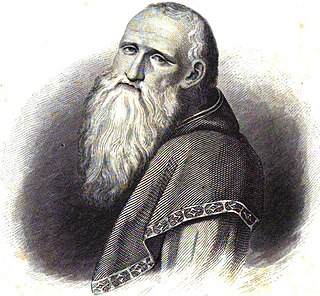
Bernardino Luini was a north Italian painter from Leonardo's circle during the High Renaissance. Both Luini and Giovanni Antonio Boltraffio were said to have worked with Leonardo directly; he was described as having taken "as much from Leonardo as his native roots enabled him to comprehend". Consequently, many of his works were attributed to Leonardo. He was known especially for his graceful female figures with elongated eyes, called Luinesque by Vladimir Nabokov.

Ambrogio Borgognone was an Italian painter of the Renaissance period active in and near Milan.

Antonio di Benedetto Aquilo degli Aquili, known as Antoniazzo Romano, was an Italian Early Renaissance painter, the leading figure of the Roman school during the latter part of the 15th century. He "made a speciality of repainting or interpreting older images, or generating new cult images with an archaic flavor", in particular by very often using the gold ground style, which was unusual by this period.

Giovanni Antonio Boltraffio was an Italian painter of the High Renaissance from Lombardy, who worked in the studio of Leonardo da Vinci. Boltraffio and Bernardino Luini are the strongest artistic personalities to emerge from Leonardo's studio. According to Giorgio Vasari, he was of an aristocratic family and was born in Milan.
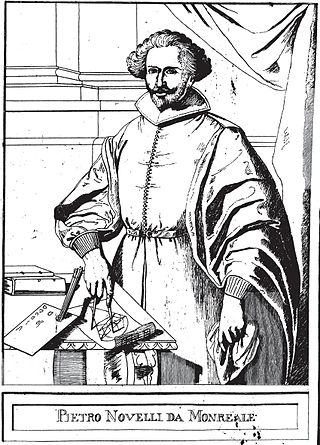
Pietro Novelli was an Italian painter of the Baroque period, active mainly in Palermo. Also known as il Monrealese or Pietro "Malta" Novelli to distinguish him from his father, Pietro Antonio Novelli I. He was also nicknamed by contemporaries as the Raphael of Sicily.
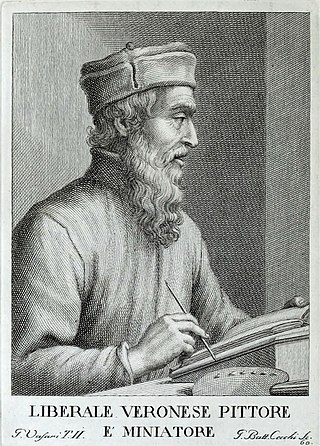
Liberale da Verona (1441–1526) was an Italian painter of the Renaissance period, active mainly in Verona.
The decade of the 1460s in art involved some significant events.

Bartolomeo Cavarozzi (1587–1625), occasionally referred to as Bartolomeo Crescenzi, was an Italian caravaggisti painter of the Baroque period. Cavarozzi's work begin receiving increased admiration and appreciation from art historians in the last few decades of the 20th century, emerging as one of the more distinct and original followers of Caravaggio. He received training from Giovanni Battista Crescenzi in Rome and later traveled to Spain alongside his master for a few years where he achieved some renown and was significant in spreading "Caravaggism" to Spain before returning to Italy. His surviving works are predominantly Biblical subjects and still-life paintings, although older references note he "was esteemed a good painter especially of portraits".

Lorenzo di Bicci was an Italian painter of the Florentine School considered to be one of the most important painters in Florence during the second half of the 14th century. He is believed to have learned his trade from his father, about whom little is known. Lorenzo’s style, as well as that of his contemporaries Jacopo di Cione and Niccolò di Pietro Gerini, was influenced by the artist Andrea di Cione. Lorenzo's paintings made use of bright colors and his compositions avoided complexity. The figures he painted tended to have round faces and were often expressionless. Another one of Lorenzo's distinctive characteristics was his precision of execution. He was known for exceptional talent in drawing, an ability that he put to use at the initial stages of his painting. Unlike many celebrated Florentine artists of this period, Lorenzo mostly received commissions from the country clergy and from the lower-middle-class Florentine guilds. His successors, Bicci di Lorenzo and Neri di Bicci, continued to serve these groups.

Bastiano di Bartolo Mainardi (1466–1513) was an Italian painter of the Early Renaissance. He was born in San Gimignano and was active there and in Florence.
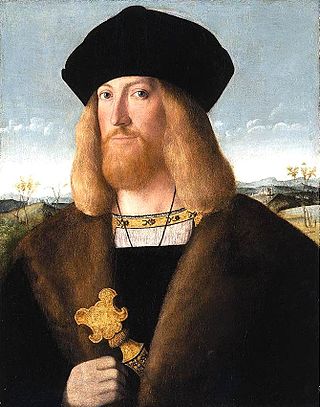
Bartolomeo Veneto was an Italian painter who worked in Venice, the Veneto, and Lombardy. During his time in Venice, he studied under Gentile Bellini. The little information available about Bartolomeo's life has been derived from his signatures, dates, and inscriptions. His best-known works are portraits or pictures with portrait-like character. Bartolomeo's later works, and especially those done on commission in Milan, indicate an influence from the artist Leonardo da Vinci.
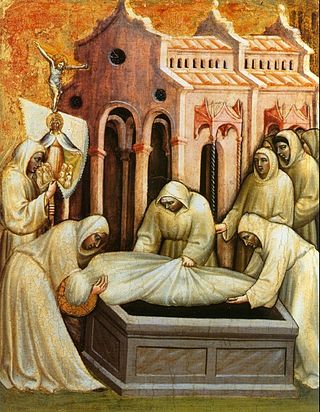
Olivuccio Ceccarello di Ciccarello was an Italian painter. Little is known of his life. He was a native of Camerino and was active from 1388 until his death. In 2002 works formerly attributed to an obscure painter named Carlo da Camerino were re-attributed to Olivuccio di Ciccarello as it had become clear Carlo da Camerino had never existed.

Antonio del Massaro da Viterbo, or Antonio da Viterbo, nicknamed il Pastura was an Italian painter.

The Basilica of St. Francis is a parish church and minor basilica in Viterbo, central Italy. The museological management of the church is run by the Polo Museale del Lazio.

Pietro di Miniato or Pietro di San Miniato was an Italian painter, active in Florence and Prato, in a Gothic style. He collaborated with a relative Antonio di Miniato di Piero, likely his son, active circa 1430 in and around Prato. Among the works attributed to him are a painted crucifix in the St Louis Museum of Art, a polyptych in the Museo Civico of Prato, a painted mural in the church of San Niccolò in Prato, and a mural in the Chapel of San Stefano of the Duomo di Prato, depicting the Virgin and child flanked by saints.